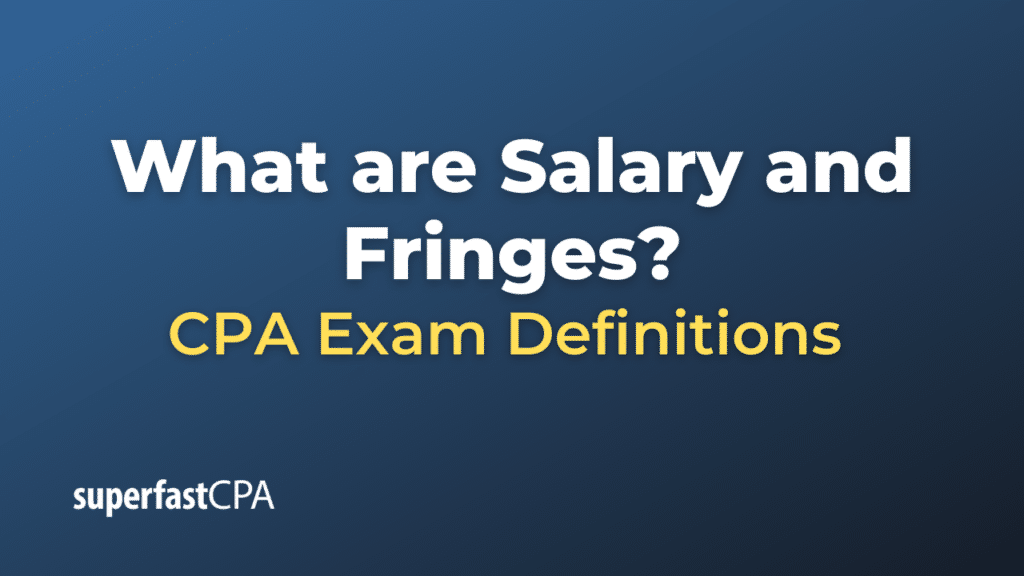Salary and Fringes
“Salary and fringes” refer to the combination of an employee’s basic salary (or wages) along with the fringe benefits they receive as part of their compensation package. Let’s break down these components:
- Salary: This is the regular compensation an employee receives, typically as a fixed annual amount, which may be paid weekly, bi-weekly, monthly, etc. It’s the base compensation for the job role and doesn’t depend on the actual number of hours worked (unlike hourly wages).
- Fringes (Fringe Benefits): These are additional benefits provided to employees beyond their regular salary or wages. Fringe benefits can encompass a wide variety of offerings, and some examples include:
- Health Insurance: Coverage for medical, dental, or vision care.
- Retirement Benefits: Employer contributions to pension plans or 401(k) matching.
- Paid Time Off: This can include vacation days, sick leave, personal days, or holidays.
- Life Insurance: Some employers provide life insurance coverage as a benefit.
- Disability Insurance: Coverage that provides for payment of benefits to the insured if income is interrupted by illness, sickness, or accident.
- Tuition Assistance: Employers might offer to pay for courses or degrees to enhance employee skills.
- Company Car or Transportation Benefits: Provided for roles that require frequent travel.
- Meal or Food Benefits: Some companies offer free meals, food allowances, or catered lunches.
- Stock Options or Bonuses: Incentives based on performance or company profitability.
In some contexts, particularly in grant applications or budgeting for projects, “salary and fringes” might be listed as separate line items to detail the total cost of employing someone, accounting for both their base compensation and the additional costs associated with their benefits.
For instance, if an employee has a salary of $50,000 annually and receives fringe benefits equivalent to an additional 30% of their salary ($15,000 in this case), the total cost to the employer for “salary and fringes” would be $65,000.
It’s also worth noting that fringe benefits may be taxable, depending on the jurisdiction and the nature of the benefit. In many cases, specific documentation and calculations are required to determine the tax implications of these benefits.
Example of Salary and Fringes
Let’s consider a hypothetical scenario involving an employee named David who works as a Project Manager at a construction company, “BuildTech Inc.”
David is hired at BuildTech Inc. with the following compensation package:
Salary:
- Annual base salary: $70,000
Fringe Benefits:
- Health Insurance: BuildTech covers 80% of the health insurance premium, which amounts to $6,000 annually for David’s plan.
- Retirement Benefits: BuildTech matches David’s 401(k) contributions up to 5% of his base salary.
- Paid Time Off: David gets 20 days of paid vacation, which, when considering his daily rate (base salary/365 days), equates to a value of approximately $3,835.
- Life Insurance: The company provides a life insurance policy with a value of $1,000 annually.
- Tuition Assistance: David takes a course to further his expertise, for which BuildTech pays $2,500 annually.
- Transportation Benefit: David receives a monthly transportation allowance for his commute, totaling $1,200 annually.
Calculations:
To determine the total cost to BuildTech for David’s “salary and fringes”:
- Health Insurance: $6,000
- Retirement Benefits (5% of $70,000): $3,500
- Paid Time Off: $3,835
- Life Insurance: $1,000
- Tuition Assistance: $2,500
- Transportation Benefit: $1,200
Total Fringe Benefits: $6,000 + $3,500 + $3,835 + $1,000 + $2,500 + $1,200 = $18,035
Total Salary and Fringes: $70,000 (base salary) + $18,035 (fringe benefits) = $88,035
In this example, David’s actual cost to BuildTech Inc. is not just his base salary of $70,000, but a total of $88,035 when factoring in all the fringe benefits he receives. This comprehensive view provides a clearer understanding of an employee’s complete compensation package and the total financial obligation on the part of the employer.













